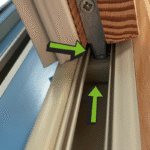Have you ever found yourself standing at your door, only to realize your deadbolt is stuck in the locked position? It’s frustrating, stressful, and can make you feel helpless—especially when you need quick access.
But don’t worry, you’re not alone, and there are simple steps you can take to fix this common problem. You’ll discover why your deadbolt gets stuck and how to unlock it without damaging your door or lock. Keep reading, because regaining control over your door is easier than you think.
Common Causes Of A Stuck Deadbolt
A deadbolt stuck in a locked position can cause frustration and worry. Understanding the common causes helps solve the problem quickly. Several factors can make a deadbolt hard to turn or stuck.
Knowing these causes can save time and avoid damage to your door or lock. Here are the main reasons deadbolts get stuck.
Weather And Temperature Effects
Cold weather makes metal parts shrink and tighten inside the lock. Heat can cause expansion and make the deadbolt stick. Moisture from rain or snow can freeze inside the lock. This ice blocks the deadbolt’s movement.
Misalignment Issues
Doors and frames can shift over time due to settling or force. This shift causes the deadbolt to not line up with the strike plate. A deadbolt that does not fit right will jam or get stuck. Misalignment also wears out parts faster.
Rust And Dirt Build-up
Rust forms on metal parts when exposed to moisture. Dirt and dust enter the lock from outside air. Rust and dirt cause friction inside the lock mechanism. This friction makes turning the deadbolt difficult or impossible.
Worn Out Internal Components
Moving parts inside a deadbolt wear down with use. Springs lose tension and pins get stuck or broken. Worn parts fail to move smoothly and lock properly. This wear can cause the deadbolt to jam or lock up.

Credit: www.reddit.com
Tools Needed For Quick Fixes
Fixing a deadbolt stuck in a locked position needs the right tools. Having these tools ready saves time and effort. This section lists essential items for quick deadbolt repairs. Prepare them before starting your fix. Simple tools can solve many common problems fast.
Lubricants And Cleaning Supplies
Lubricants help the deadbolt move smoothly. Use graphite powder or silicone spray for best results. Avoid oil-based lubricants that attract dirt. Cleaning supplies include a soft cloth and mild detergent. Clean dust and grime from the lock to prevent jams. Proper lubrication often frees a stuck deadbolt quickly.
Basic Hand Tools
Basic tools are needed to open and adjust the lock. A screwdriver set with flathead and Phillips heads works well. Pliers help pull or twist small parts gently. A small hammer can tap stuck components carefully. These tools allow you to remove covers and access internal parts easily.
Replacement Parts
Sometimes, broken parts cause the deadbolt to stick. Keep extra screws and springs on hand. A new latch or cylinder may be necessary for major damage. Purchase parts that fit your lock model exactly. Having replacements ready speeds up the repair process. Check the lock’s brand and model before buying parts.
Step-by-step Quick Fixes
A deadbolt stuck in a locked position can cause frustration. Quick fixes often solve the problem without needing a locksmith. Follow these simple steps to get your deadbolt working again fast.
Applying Lubricant To The Deadbolt
Start by spraying lubricant into the keyhole and bolt mechanism. Use a graphite or silicone spray for best results. Avoid oil-based lubricants that can attract dirt. Move the key in and out gently to spread the lubricant. This helps the deadbolt slide smoothly.
Realigning The Door And Frame
Check if the door and frame line up properly. Misalignment can cause the deadbolt to jam. Close the door slowly and see if the bolt enters the strike plate easily. Adjust the strike plate or door hinges if needed. Realignment often fixes the stuck deadbolt quickly.
Cleaning And Removing Rust
Rust buildup can block the deadbolt from moving. Use a wire brush or steel wool to remove rust gently. Clean the key and lock with a damp cloth. Dry everything completely before testing the lock again. Clean parts help the deadbolt work smoothly.
Tightening Loose Screws
Loose screws in the lock or door frame can cause problems. Use a screwdriver to tighten all screws around the deadbolt. Check screws on the strike plate and door hinges too. Secure screws keep the deadbolt aligned and functional.

Credit: www.youtube.com
When To Call A Professional
Knowing when to call a professional for a stuck deadbolt saves time and avoids damage. Some problems need expert tools and skills to fix safely. Trying to force the lock can worsen the issue or break the door.
Signs Of Internal Damage
If the deadbolt won’t turn smoothly or feels jammed inside, internal parts may be broken. Scratches, rust, or broken pieces inside the lock show damage. A professional can open the lock to check and replace broken parts.
Complex Lock Mechanisms
Modern deadbolts often have advanced features or electronic parts. These locks are tricky to repair without special knowledge. Professionals understand different lock types and have the right tools for complex repairs.
Safety And Security Concerns
A stuck deadbolt risks home security. A poorly fixed lock might not protect your door well. Experts fix the lock to ensure it works perfectly and keeps your home safe. Don’t risk your safety with a quick, incorrect fix.
Preventing Future Deadbolt Issues
Deadbolt locks are important for home security. A stuck deadbolt can cause frustration and safety concerns. Preventing future problems helps keep your lock working smoothly. Simple steps can extend the life of your deadbolt. Regular care and smart choices stop issues before they start.
Regular Maintenance Tips
Check your deadbolt often for dirt and dust. Clean the keyhole and bolt with a soft cloth. Use graphite powder or a lock lubricant to keep parts moving. Avoid oil-based sprays that attract grime. Test the lock monthly to find problems early. Tighten loose screws to keep the lock stable.
Weatherproofing Strategies
Rain and cold can harm your deadbolt. Install a weather shield to protect the lock. Use a door sweep to stop water and dust from entering. Keep the lock dry by wiping off moisture quickly. Choose locks with rust-resistant finishes for outdoor doors. These steps help your deadbolt last longer in all weather.
Choosing Durable Deadbolt Locks
Select deadbolts made from strong materials like solid brass or steel. Look for locks with a high security rating. Simple designs often work better and last longer. Avoid cheap locks that break or jam easily. Pick a lock that fits your door well. Good quality deadbolts reduce the chance of getting stuck.

Credit: www.youtube.com
Frequently Asked Questions
Why Is My Deadbolt Stuck In The Locked Position?
Deadbolts can stick due to dirt, rust, or misalignment in the lock or door frame.
How Can I Fix A Deadbolt Stuck In Locked Mode?
Try lubricating the lock with graphite powder and gently wiggle the key or knob.
Can Temperature Changes Cause A Deadbolt To Stick?
Yes, cold weather can shrink metal parts, making the deadbolt harder to turn.
When Should I Call A Locksmith For A Stuck Deadbolt?
Call a locksmith if the deadbolt won’t move after lubrication and gentle attempts.
Is It Safe To Force A Stuck Deadbolt Open?
Forcing a deadbolt may damage the lock or door; avoid using excessive force.
Conclusion
A deadbolt stuck in a locked position can cause stress. Quick action helps avoid bigger problems later. Try simple fixes like lubrication or realigning the lock. If these don’t work, call a locksmith for help. Regular maintenance keeps locks working smoothly.
Always check locks before leaving your home. Staying calm and patient makes the process easier. A stuck deadbolt is frustrating but fixable. Keep your home safe with proper lock care.



